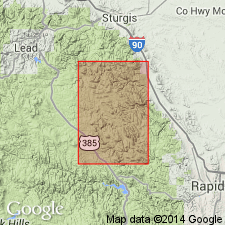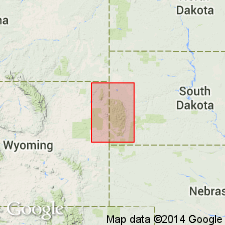
- Usage in publication:
-
- Boxelder Creek Quartzite*
- Modifications:
-
- Named
- Dominant lithology:
-
- Quartzite
- Schist
- AAPG geologic province:
-
- Midcontinent region
Summary:
Named as the lower formation of the Nemo Group (reduced in rank) for exposures along Boxelder Creek, sec 20, T3N, R5E, Lawrence Co, SD in the Midcontinent region. These exposures are the type locality. Mapped in the central and southeast part of map in Meade, Lawrence, and Pennington Cos. Unconformably overlies early Precambrian Little Elk Granite. Unconformably? underlies middle Precambrian Benchmark Iron-formation (new) of Nemo Group. Consists of light-colored cross-bedded orthoquartzite and quartz-mica schist. Of middle Precambrian age.
Source: GNU records (USGS DDS-6; Denver GNULEX).

- Usage in publication:
-
- Boxelder Creek Formation*
- Modifications:
-
- Age modified
- AAPG geologic province:
-
- Midcontinent region
Summary:
Also called Boxelder Creek Quartzite. Mapped with other iron-formations (units Xgb, Xc, Xcq, pl. 1) of Early Proterozoic age. Thought to be between 2.2 and 2.5 Ga or of Early Proterozoic age. Intruded by the Blue Draw Metagabbro (2.2 Ga). Unconformably overlies Nemo Iron-formation. Geologic map.
Source: GNU records (USGS DDS-6; Denver GNULEX).
For more information, please contact Nancy Stamm, Geologic Names Committee Secretary.
Asterisk (*) indicates published by U.S. Geological Survey authors.
"No current usage" (†) implies that a name has been abandoned or has fallen into disuse. Former usage and, if known, replacement name given in parentheses ( ).
Slash (/) indicates name conflicts with nomenclatural guidelines (CSN, 1933; ACSN, 1961, 1970; NACSN, 1983, 2005, 2021). May be explained within brackets ([ ]).

